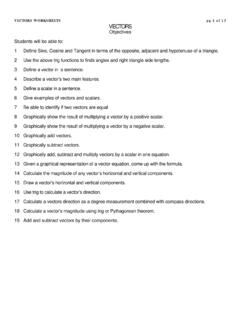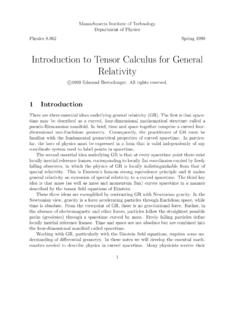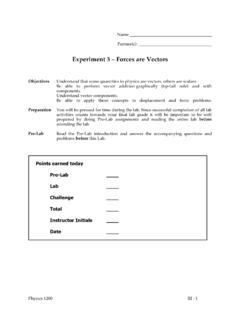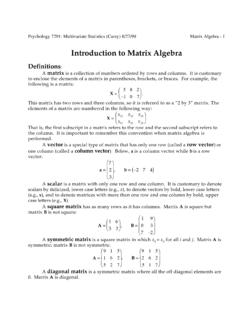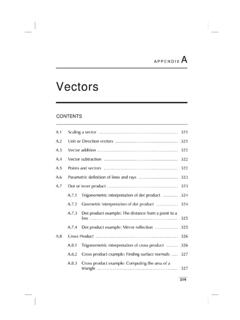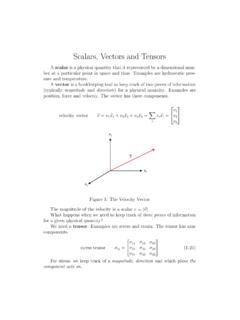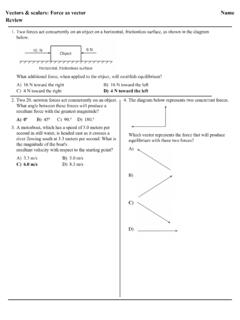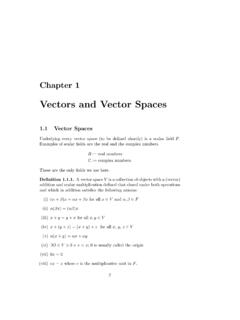Transcription of 1 Vectors in 2D and 3D - Stanford University
1 CME 100 Fall 2009 Lecture NotesEric DarveReading:Thomas - , , and Vectors in 2D and Definition of vectorsMany times in engineering, one wants to model quantities that are not adequately described by asingle number, like temperature or pressure, but rather by adirectionandmagnitude. These arecalledvector quantitiesor simplyvectors. Examples of vector quantities are: Force: it has a magnitude, the strength, and a direction. Velocity: it also has a magnitude, the speed, and a direction. Acceleration. Electric and magnetic fields. A trajectory when moving along a straight line for some NotationIf a quantity is a vector , then it is either going to be in boldface, such asuor have an arrow overit, such as~ Geometric interpretation of a vectorA vector ~uhas a direction and a magnitude.
2 A convenient geometrical representation of vector isa straight line segment drawn in space in the direction of the vector , with an arrowhead indicatingits sense. The length of the line segment is given by the magnitude of the vector . This is sometimescalled adirected straight line this course, we will primarily use the Cartesian coordinate system to represent Vectors analyti-cally, that is using numbers. Let s assume that we draw a vector ~ustarting from the origin. It willend at some pointPwith Cartesian coordinates (u1,u2,u3). By definition, these are theCartesiancoordinatesof vector ~u.
3 For example, on Figure 1, the Vectors ~u= (4,3) and~v= (2,3,1) areshown. The magnitude or length of~uis given by:|~u|= u21+u22+ vector operationsWe can define operations on Vectors as with scalars, but one has to be a little more multiplicationfor a vector ~u= (u1,u2,u3) is defined ask~u= (ku1,ku2,ku3)2/131 CME 100 Fall 2009xy(4,3)~u43(0,0)(a) 2D Vectoryz(2,3,1)~vx(0,0,0)321(b) 3D VectorFigure 1: Geometric Interpretation of a vectorMultiplying a vector with a scalar does not change its direction, but it changes the length of thevector. To see this, note thatk~u= (ku1,ku2,ku3) and the length is now given as|k~u|= (ku1)2+ (ku2)2+ (ku3)2=|k| u21+u22+u23=|k||~u|A common mistake in computing the length of a vector is to forget the absolute value,| |, aroundk.
4 Remember that length cannot be negative!The effect of multiplying a vector ~uwith scalars , 1 and is given in Figure 2 in differentcolors. Note that the different Vectors all lie on top of each other as scalar multiplication of a vectorcannot change the direction of the vector , except for reversing it. But scalar multiplication doeschange the magnitude of~u!xy~u(0,0) ~ ~ ~uFigure 2: Scalar multiplication of a vectorVector additionfor two Vectors ~u= (u1,u2,u3) and~v= (v1,v2,v3) is defined as~u+~v= (u1+v1,u2+v2,u3+v3)As with other operations, vector addition also has a nice geometric interpretation and can be seenvia the well knownParallelogram Lawor theTriangle Law.
5 These are depicted in Figure 100 Fall 20093/131~v~u~u+~v~v~u~u+~vFigure 3: The parallelogram law and the triangle law of vector addition. The parallelogram lawstates that if one draws a parallelogram with~uon one side and~von the other then~u+~vis givenby the diagonal of the parallelogram. The triangle law states that if you draw vector ~uand vector ~vstarting at the end of~u, and then join the first and last points, you obtain vector ~u+~ Standard basisA 3D vector can be conveniently represented using thestandard basis:~i= (1,0,0)~j= (0,1,0)~k= (0,0,1)Each of these Vectors ~i,~jand~khas only one non-zero component out of three.
6 Any vector ~u= (u1,u2,u3) can be written using the standard basis as~u= (u1,u2,u3)= (u1,0,0) + (0,u2,0) + (0,0,u3)=u1(1,0,0) +u2(0,1,0) +u3(0,0,1)=u1~i+u2~j+u3~kNote each of these standard basis Vectors points in the direction of one axis in the Cartesiancoordinate Displacement VectorThe displacement vector PQdefines a vector starting at pointP= (x1,y1,z1) ending at a pointQ= (x2,y2,z2) and is shown in Figure 4. As with any other vector , PQhas a direction and amagnitude (or length), and in this case the direction is the direction going fromPtoQ, and themagnitude is the distance betweenPandQ.
7 The coordinates of the displacement vector are: PQ= (x2 x1,y2 y1,z2 z1)The distance betweenPandQis equal to the length of PQand therefore is given by:| PQ|= (x2 x1)2+ (y2 y1)2+ (z2 z1)2 Example two pointsP= (1, 1,2)andQ= ( 1,1,1), compute the distance between thetwo , let us compute the displacement vector PQ: PQ= ( 1 1,1 ( 1),1 2) = ( 2,2, 1)4/131 CME 100 Fall 2009yzQ= (x2,y2,z2) PQxP= (x1,y1,z1)Figure 4: The displacement vector fromPtoQThen, the length of~PQis given by| PQ|= ( 2)2+ 22+ ( 1)2= 9 = 3 Thus, the distance betweenPandQis Unit VectorWe define~uto be a unit vector if~uhas unit length, ,|~u|= vector ~ucan be decomposed as a length times a unit vector and this can be seen as follows:~u=|~u|(~u|~u|)The vector ~u/|~u|has unit length since: ~u|~u| =1|~u||~u|= 1 The unit vector ~u|~u|denotes the direction of~uand the magnitude of~uis given by|~u|.
8 Example the vector ~u= (3, 1,2), find its length and can compute the length of~uas|~u|= 32+ ( 1)2+ 22= 14 Thus, the unit vector along~uor direction of~u, is given by:~u|~u|=(3 14, 1 14,2 14)Thus, we can write the vector itself as its length times the direction:~u= 14 (3 14, 1 14,2 14)CME 100 Fall 20095/131 Example airplane flying due east at 500 mph in still air encounters a 70 mph tailwindacting in the direction 60 north of east. Determine the airplanes ground speed and direction. ur wr vr Matlab code:% Define Vectors % u velocity of plane with respect% to wind% v velocity of wind with respect to% groundu=[500,0]u =500 0v=[70*cos(60*pi/180), 70*sin(60*pi/180)]v = Add u and vw=u+vw = Find magnitude of wspeed=norm(w)speed = Determine directiontheta=atan(w(2)/w(1))*180/pithe ta = Dot ProductThe dot product of two Vectors ~u= (u1,u2,u3) and~v= (v1,v2,v3) is defined as~u ~v=u1v1+u2v2+u3v3 Note that the dot product of two Vectors always results in PropertiesA few properties of the dot product are.
9 6/131 CME 100 Fall 20091. The dot product of a vector with itself gives the square of its magnitude:~u ~u=|~u|22. The dot product is commutative:~u ~v=~v ~u3. The dot product is distributive:~u (~v+~w) =~u ~v+~u ~ Geometric interpretation of the dot productRecall that the law of cosines for two Vectors states that (see Figure 5):|~u ~v|2=|~u|2+|~v|2 2|~u||~v|cos (1)~v~u~u ~v Figure 5: The law of cosinesUsing the properties of the dot product, we can calculate|~u ~v|2in the following manner:|~u ~v|2= (~u ~v) (~u ~v)=~u ~u ~u ~v ~v ~u+~v ~v=|~u|2+|~v|2 2(~u ~v)(2)Comparing Equation (1) and (2), we have~u ~v=|~u||~v|cos Thus, the angle between 2 Vectors ~uand~vcan be computed as.
10 = arccos(~u ~v|~u||~v|)Note that this directly implies that:If~u ~v= 0, then~uand~vare ~u= (1,3)and~v= ( 1,1), find the angle between have|~u|= 12+ 32= 10. Similarly,|~v|= ( 1)2+ 12= 2. Also, we can compute~u ~v= 1 ( 1) + 3 (1) = 2. Then the angle between the Vectors is given by = arccos(2 10 2)= arccos(1 5) 63 CME 100 Fall 20097 ProjectionsBy projection of~ualong~v, we mean the component of~uin the direction of~v. The scalar componentof~uin the direction of~vis given by:|~u|cos =~u ~v|~v|We can also define the vector projection of~uonto~vas (see Figure 6):proj~v~u=(~u ~v|~v|) (~v|~v|)=(~u ~v|~v|2)~v~v~uproj~v~u Figure 6: vector projection of~uonto~ component of~uperpendicular to~vcan be computed by subtracting from~u, the component of~ualong~v:~u (~u ~v|~v|2)~ Physical application of the dot productThe work done by a force~Facting on a particle that moves in a straight line in the direction of~dand by a distance|~d|is given by.
